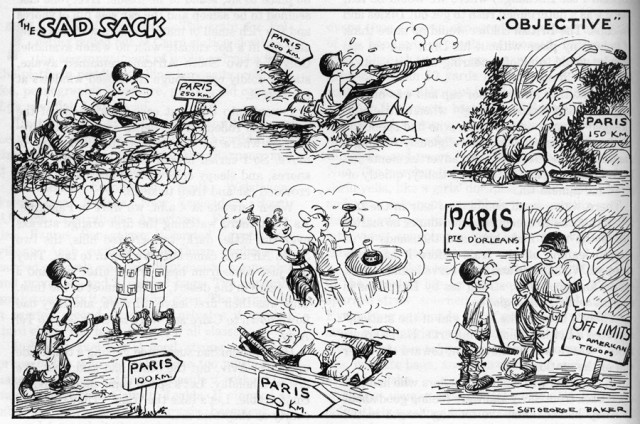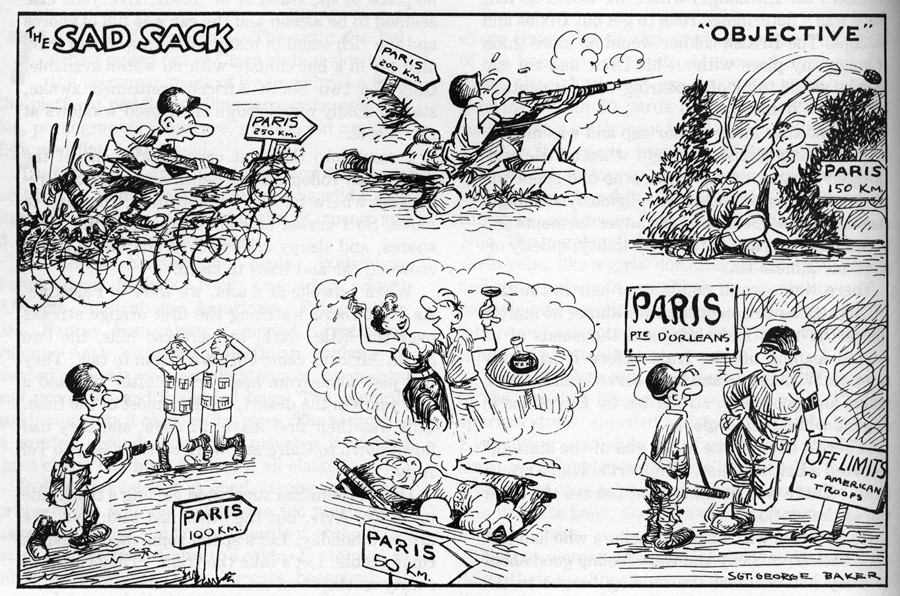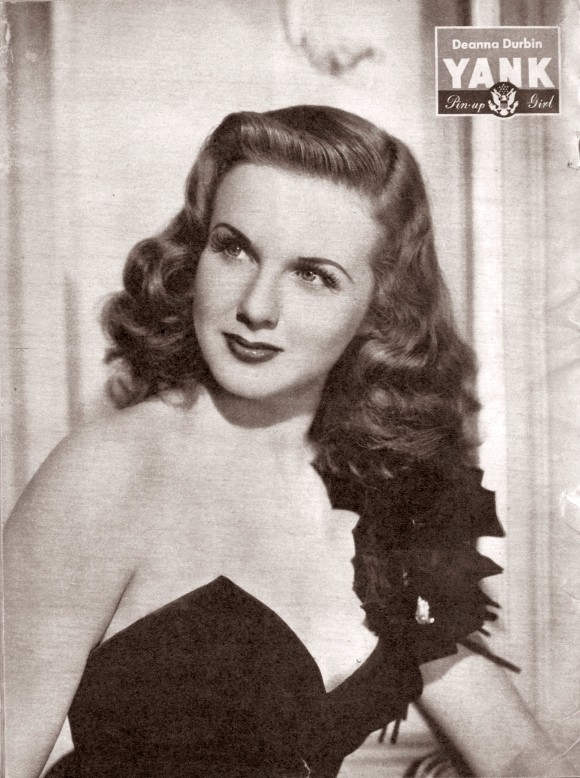FORT MONMOUTH, N.J. -- It became the most widely read publication in U.S. military history, boasting more than two million copies worldwide during its four-year reign.
And though it was supposed to sell for a nickel a copy, most World War II veterans have no recollection of ever buying one, nor do they recall the first time they read it.
What yesteryear's Soldiers agree on is that Yank-The Army Weekly, featuring stories about WWII, cartoons poking fun at service life and pin-up girls-was always there when they needed it most.
"Yank was a brilliant mixture of good information as well as humor, which kept you up with the times," said Roger Ryskamp, Supreme Headquarters Allied Expeditionary Forces - Europe. "More importantly, Yank gave the reasons why you were there. It was instrumental in making day-to-day living in a world war a lot more bearable."
Capt (Ret.) Ted von Gerichten, 90th Infantry Division, remembered Yank was passed out to Soldiers in the field along with chewing gum and cigarettes.
"By the time I was serving in Europe, everything was devastated. People just looked pitiful. Yank reminded us that back home there was something wonderful waiting for us," said von Gerichten.
Twenty-one weekly editions circulated around the world in 17 locations from 1942 to 1945.
Its 127 staff members, consisting of editors, staff writers, photographers and artists, were all enlisted active duty Soldiers who designed and dedicated the publication especially for the low ranking Soldiers during WW II.
From its first publication on June 6, 1942, one of Yank's biggest attractions was humor in cartoon form about a dejected, put-upon private named "The Sad Sack."
"We loved 'The Sad Sack' because it was about screw-ups, and he was always screwing up," laughed Frank Invernale, 1st Cavalry Division. "And there was always somebody like that in your outfit, which made it even funnier."
The Sad Sack, created by George Baker when he was serving at Fort Monmouth in 1942, quickly became one of the most recognizable figures throughout the war.
The droopy Soldier who constantly found himself in absurd predicaments provided the GIs much needed comic relief; a way to look at everyday Soldier life and laugh about it.
And it's hard to find a veteran who doesn't have at least one favorite cartoon he remembers to this day.
"The one that still cracks me up is The Sad Sack featured at a swinging gate in a personnel office," Ryskamp chuckled. "His paperwork is never right so he keeps going in twice for every time he comes out."
Another Yank feature was the "Poets Cornered" which published GI poems such as "Mother Goose" by Pfc. Dan Laurence in Australia:
Rock-a-bye Troopship
On the wave's top
When the surf rolls
The troopship will rock;
When the surf breaks
The Troopship will fall,
And up will come breakfast,
dinner and all.
There was also "MAIL CALL" that touted good-natured bickering between Soldiers, such as a letter by Tech Sgt. O. Nebling from Hawaii complaining about receiving a Hershey's chocolate bar with only seven almonds while another GI received one with nine.
The following week a captain and two lieutenants wrote in to explain the mistake.
"We feel that we can clearly clarify the situation by pointing out that through some gross and unpardonable error the other Soldier undoubtedly received an officer's Hershey bar," they wrote.
And then there were the girls. The beautiful pin-up girls etched forever into the memories of every Soldier who gazed upon them.
It was also an idea that nearly got the proposal of Yank rejected. On a second attempt, however, Deanna Durbin, a young Hollywood starlet featured in a Sunday school party gown, won approval and a thumbs-up for publication.
"I think they were the most beautiful women I ever saw!" von Gerichten exclaimed. "And Soldiers always looked forward to those pin-ups. Rita Hayworth in that nightgown is my overall favorite!"
Procter Ely, 3rd Infantry Division, swears it was Rita Hayworth's hair that made her one of the most popular. "I still remember her picture being painted on planes and trucks, especially near the front where you could get away with a whole lot more than usual," he said.
Betty Grable with "those beautiful set of legs," is another great favorite among the veterans, especially with Ryskamp. "As a matter of fact, she looked great overall," he added.
And the intention of publishing pin-ups was well fulfilled according to von Gerichten.
"Any place we could stick those girls up we did. On a wall or locker. When you moved out they went into your trunk which was back in the rear. But the second you were in a room or a house, anything like that, and the war settled down for five minutes, back up they went," he said.
Pin-ups also proved to be a valuable educational tool for Soldiers. Betty Grable's renowned leg poster taught map reading by placing a grid over her picture. "You learned real quick to read a map that way," von Gerichten grinned.
Von Gerichten is also quick to point out it was not only the performers' beauty that compelled Soldiers to adore Yank's pin-ups, but their exquisite talent as well.
"Ann Miller was famous for fast tap dancing. The Army wanted to find out how fast she was, so they had her tap to a machine gun, which at the time could fire up to 700 rounds-a-minute. It turned out she was faster than that!" von Gerichten said.
But Yank wasn't just about cartoons and women. The writings of the dedicated reporters serving alongside their traditional comrades-in-arms on three continents and 100 islands, are as extraordinary and significant today as they were half-a-century ago.
The stories of the powerful unfolding drama of the Normandy invasion, the moving tribute to Bataan, and the desperate struggle to save lives in a returning hospital ship, provided America's fighting Soldiers information they might never have known.
"Yank was about the only way you found out what you were doing compared to everybody else," von Gerichten said. "You had very little of the overall picture. Yank would show up and you could find out where everybody was, not to mention yourself. There were times we didn't even know what country we were in."
Ely agrees that after the jokes and admiration of pin-ups, soldiers took time to read the battle accounts and the latest happenings of the war. "Everybody loved the Yank feature stories," Ely said, "because they were actual stories about how we were living at the time."
Many WWII Soldiers also found themselves gracing the cover of Yank Magazine.
Like Sgt. William Phelps, 11th Armored Division, who stopped to sew his pants after the Battle of the Bulge. Seated in front of a tank and surrounded by snow and wilderness, Phelps is expertly repairing his uniform with a White sewing machine.
"My tank crew happened upon this demolished house and I found this sewing machine inside that I had learned to use as a boy," said Phelps. "I was stitching away when this flash went off. Three weeks later during a firefight a jeep pulled up, yelled my name, and threw me a package. It wasn't until several hours later I opened it up and found myself on the front cover of Yank Magazine."
As for World War II veterans like Procter Ely, Yank will always have a sacred place in his memory as he proclaims it wouldn't have been the same war without it.
"Yank gave us laughter; it boosted morale. You'd be feeling bad about yourself and then you'd read The Sad Sack and he'd have it worse," Ely said.
Yank had a very real place with the average GI," Roger Ryskamp added, "because it dealt with them. What they liked and didn't like."
Von Gerichten says he has no explanation as to why he collected and held on to several Yank pin-up posters that have been in his attic for more than 50 years.
"I think they just remind me of a time gone by when I was young and foolish. I think these ladies gave Soldiers something to look forward to," he said. "Even if we didn't personally have anybody back in the states like that, they still represented home. And that meant we could look forward to some place and some time that was better than where we were. That made America worth fighting for."
(Editor's note: This is the third story in a series featuring World War II novelties.)




Social Sharing